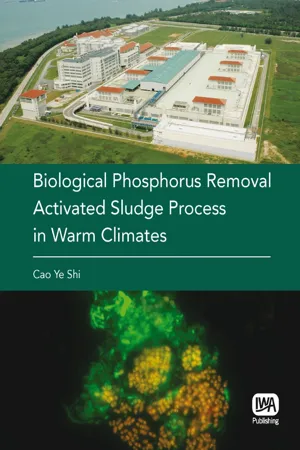
- 168 pages
- English
- PDF
- Available on iOS & Android
Biological Phosphorus Removal Activated Sludge Process in Warm Climates
About This Book
Special Offer: Cao Ye Shi Author Set - Buy all three books together and save a total £76!
Biological Phosphorus Removal Activated Sludge Process in Warm Climates presents the results of detailed research on the Enhanced Biological Phosphorus Removal (EBPR) activated sludge process under warm climate conditions (20 o C - 30 o C), which is part of the R & D program of Public Utilities Board (PUB) Singapore. The investigations and studies presented in this book are application-oriented, but at the same time the studies aim at an insightful understanding of the EBPR with the knowledge of the latest development in academic field.
The focus points are:
- EBPR performance of laboratory-scale and full-scale activated sludge processes under the site conditions in warm climates
- The carbon competition and distribution between PAO and GAO (and denitrifiers) in the process
- The stoichiometry and kinetics of P-release, COD uptake in the anaerobic environment and P-uptake in the aerobic environment under different temperatures and operating conditions
- PAO and GAO population fractions, shift and dominance studies using FISH and batch tests
- The inter-relationships between the system performance, process design and the microbial community
- EBPR for industrial wastewater (high ratio of feed COD/P) treatment under warm climates.
Together with the preceding book –Biological Nitrogen Removal Activated Sludge Process in Warm Climates– published by IWA in 2008, this book fills the gap of biological nutrient (nitrogen and phosphorus) removal in warm climates and provides unique experiences and knowledge for Process and design researchers and engineers in wastewater research, students and academic staff in Civil/Sanitation/Environment Departments, as well as Managers, Engineers and Consultants in water companies and water utilities.
Visit the IWA WaterWiki to read and share material related to this title: http://www.iwawaterwiki.org/xwiki/bin/view/Articles/SELECTIONOFDOMESTICWASTEWATERTREATMENTSYSTEMSINWARMCLIMATEREGIONS
Frequently asked questions
Information
Table of contents
- Half title
- Title page
- Copyright page
- Contents
- Preface
- Acknowledgements
- About the author
- Nomenclature
- Chapter 1
- Chapter 2
- Chapter 3
- Chapter 4
- Chapter 5
- Chapter 6
- Chapter 7
- References
- Index